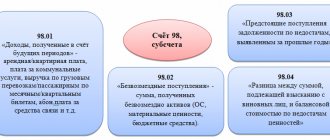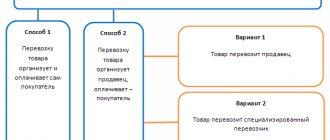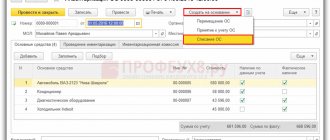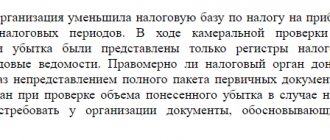Temporary difference
According to Order No. 114n of the Ministry of Finance of the Russian Federation dated November 19, 2002, deviations in calculations that arise between two standards are interpreted as follows:
Depending on the situation, different amounts of income/expenses may appear in the accounting and tax reports. In order to eliminate this difference in future reporting periods, the concept of “temporary difference” is used.
A temporary difference is an accounting profit or loss of one reporting period, subject to the tax base of another (other) reporting periods.
Definition and causes of occurrence
A huge number of companies in the process of carrying out financial and economic activities are faced with such a concept as a deferred tax asset. Such a phrase, at first glance, seems somehow incomprehensible.
If we talk about the nature of account 09, then it is active. The debit part of it reflects the accumulated amounts of deferred tax assets, while the credit part reflects their write-off.
As for the definition of this concept, experts and current legislation explain it as the total difference in income tax, which is formed when a difference arises in accounting and fiscal accounting. The identified deviations according to fiscal and financial reporting data were defined as “deductible temporary differences”, i.e. they take place only for some time.
To put it simply, account 09 forms part of the income tax, which is transferred to the following reporting periods. Thus, companies and organizations postpone for a certain period of time the fulfillment of obligations to pay taxes to the budget.
During the next fiscal period, these amounts are accumulated in item 09 of the balance sheet for each business transaction separately. In this situation, their merging is unacceptable. At the end of this period, the result obtained is transferred to line 1180 of the balance sheet in the non-current assets section.
If we try to identify the reasons that lead to this situation, we should note the following factors:
- the excess of the amount of tax paid to the state treasury over the amount of the accrued liability;
- if, in accordance with the company’s accounting policy, a reserve fund is formed for the payment of vacation pay;
- features of the procedure for making managerial and commercial decisions in fiscal and accounting reporting;
- if the company suffered losses as a result of the sale of the fixed assets.
Deferred tax asset
If the tax authorities recognized the receipt of profit in their report earlier than they did in the company’s accounting department, then the same temporary difference arises. In this case - deductible. This means that in the next reporting periods the company will pay less income tax. The deferred tax asset is the part of the amount by which the tax will be reduced. Thus, the difference in the two types of reporting will disappear.
In addition to the deductible, there is also a taxable difference. It appears in the opposite case: when tax authorities receive information about profits later than recorded by the accountant. In such a situation, the tax is increased, and the amount by which it increases is called a deferred tax liability (abbreviated as IT).
In practice, assets appear more often than liabilities.
How to calculate assets
To obtain the amount of IT, the following formula is used, which is also relevant when calculating the deferred tax liability:
The temporary difference is multiplied by the income tax rate.
Situations when deferred tax assets are used
- The sale of the main product (product) of the company occurred at a loss - if the accounting department can write off this loss in the current reporting period, then the tax office will write it off for several years, during the period of use of the product (product);
- interest payments on a loan for fixed assets - according to accounting standards, are included in their own value, and the tax authorities include these expenses in the current period;
- revaluation of the difference in the rate of debt by the end of the reporting period - is valid only for accounting, the tax office revaluates the difference on the date when the debt is fully repaid;
- the company writes off expenses for processes (commercial, administrative) into cost before they are included in the tax report;
- Provisions for future expenses or doubtful debts are recognized differently from the tax authorities.
The situations described are suitable for the emergence of both assets and liabilities.
Formation of deferred tax assets when carrying forward annual losses to future periods
The loss identified based on the results of work within 12 months must be taken into account in the accounting department on the last day of the 12th month of the year. For purposes of calculating income tax, this type of expense must be recognized gradually as profits are calculated. In this case, the company is faced with the formation of a deferred asset, which must be reflected on account 09 on the last day of the year and gradually written off in future periods upon receipt of profit. The write-off is carried out on the last day of each period until it is repaid in full.
Example:
At the end of 2021 the organization summed up the results of its activities and established its negative value - the loss amounted to 800,000 rubles. This loss in accounting will be shown through appropriate entries upon detection (December 31), and in taxation it will be transferred to future periods. Due to such differences, ONA is formed.
Amount of deferred asset:
SHE = 800,000 * 20% = 160,000 rub.
The calculated value is shown as ONA on the last day of 2015.
Profit according to tax information for the first quarter. – 450,000 rubles, for 6 months. – 1,280,000 rub.
The company recognized this tax loss as follows:
- for the first quarter 2021 – share of loss for 2015 RUB 450,000;
- in 6 months 2021 – the entire amount of loss for 2015. 800,000 rub.
On the last day of each period, a double entry was made to repay the deferred asset:
- For the first quarter – 450,000 * 20% = 90,000 rub.;
- In 6 months – (800,000 – 450,000) * 20% = 70,000 rub.
Postings for this example: (click to expand)
| date | Operation | Sum | Debit | Credit |
| 31.12.15 | The deferred asset was taken into account in the form of an expense not taken into account for taxation | 160000 | 09 | 68 |
| 31.03.16 | The deferred asset is partially repaid | 100000 | 68 | 09 |
| 30.06.16 | The asset is fully repaid | 60000 | 68 | 09 |
Let's take into account the resulting loss
Of course, every company strives to make a profit. However, in practice the opposite result is also possible. Either because of miscalculations in work, or because of illiterate financial policy, the company may receive a loss instead of a profit. We’ll look at how to take it into account in the article.
L. Izotova
We write it off completely and cancel it
In accounting, both profit and loss are “bottom line results.” They are calculated taking into account all business transactions for the reporting year (clause 79 of the Regulations on accounting and financial reporting, approved by order of the Ministry of Finance dated July 29, 1998 No. 34n).
How to determine what according to accounting rules? The algorithm is simple. To collect information about the financial result, use account 99 “Profits and losses” (section VIII of the instructions for using the chart of accounts, approved by order of the Ministry of Finance dated October 31, 2000 No. 94n). During the year, at the end of each month, total data for both regular activities (from account 90 subaccount 9 “Profit/loss from sales”) and other income and expenses of the company (from account 91 subaccount 9 “Balance of other income and expenses"). Also, in the debit of account 99, the amounts of conditional income tax expense and permanent tax liabilities (clause 21 of PBU 18/02), tax sanctions and payments to the budget are taken into account.
Do not forget! Starting with the reporting for 2006, amendments to the chart of accounts introduced by Order of the Ministry of Finance dated September 18, 2006 No. 115n came into force. Now losses, income and expenses associated with emergency circumstances must be taken into account not in account 99, as was before, but in account 91 (Calculation wrote more about this in the December issue, p. 86).
All that remains is to check the result. If at the end of the year the company has a debit balance on account 99, this means that expenses exceeded income and a loss resulted. When reforming the balance, it is written off as a debit to account 84.
The obligation to cover losses on the balance sheet is unlikely to help the company obtain, for example, a bank loan. And shareholders will not like such a report. After all, having received a profit for the next year, the company will not be able to pay them dividends until it pays off the losses of previous years (Article 43 of the Law of December 26, 1995 No. 208-FZ “On Joint Stock Companies”, Article 29 of the Law of February 8, 1998 No. 14-FZ “On Limited Liability Companies”).
What to do? Firstly, in previous years, account 84 can accumulate a profit sufficient to repay the resulting “minus”. Secondly, by decision of the founders, a negative financial result can be covered by, for example, reserve or authorized capital. To do this, however, you will have to make appropriate changes to the company’s constituent documents. Thirdly, losses can be compensated using funds allocated by the founders (section VII of the instructions for using the chart of accounts, approved by order of the Ministry of Finance dated October 31, 2000 No. 94n).
A completely different procedure for accounting for losses is established by tax legislation.
We leave it for the future
In tax accounting, a loss is the negative difference between income and expenses. Both of them must be taken into account in accordance with Chapter 25 of the Tax Code (clause 8 of Article 274 of the Tax Code). If at the end of the year the company has a loss, then the tax base must be equal to zero (clause 8 of Article 274 of the Tax Code). It turns out that, unlike accounting, tax accounting does not reflect losses. It is transferred to the future (Article 283 of the Tax Code).
This means that accounting differences cannot be avoided. Moreover, the same amount of loss for the reporting period in both accounts is quite rare. After all, the rules for accounting for income and expenses do not always coincide with the procedure established by the Tax Code.
How not to get confused and take everything into account correctly? How to combine such different approaches to loss accounting? The “favorite” PBU 18/02 comes to the aid of the accountant.
Let's take into account all the differences
If a loss was incurred in accounting based on the results of work for the year, then it is necessary to determine conditional income for income tax (clause 20 of PBU 18/02). Thus, the accounting will reflect “an amount that could affect the amount of income tax for subsequent reporting periods” (clause 1 of PBU 18/02).
Conditional income is calculated as follows: the amount of the accounting loss is multiplied by the income tax rate (24%). In accounting, it is reflected in the debit of account 68 of the sub-account “Calculations for income tax” and the credit of account 99 of the sub-account “Conditional income for income tax”.
As a result, a debit balance of account 68 will appear. And this is not true. After all, due to the recognition of a loss in tax accounting, the income tax is zero. Therefore, we will adjust the balance of account 68 to the desired zero value.
Let us remember that in tax accounting we carry forward losses to the future. That is, we reduce the profit of subsequent periods by the amount of recognized losses. This means that a deductible temporary difference is formed (clause 11 of PBU 18/02). And, accordingly, a deferred tax asset. It is equal to the product of the amount of tax loss and the income tax rate (24%). The accounting entry will be as follows: debit to account 09 “Deferred tax assets”, credit to account 68 sub-account “Calculations for income tax”.
Do not forget that deferred taxes are possible only if the company will still make a profit in the future. Then these taxes will be paid off. If there is no hope that the loss will be covered, then permanent rather than temporary differences should be recognized. And they already form permanent tax obligations that do not need to be repaid in the future. For example, such a situation may arise due to a reduction in production volumes and a decrease in demand, or due to a large accounts payable of the company.
Let's consider several situations that a company may encounter, given the negative financial results of its work.
The simplest option is when accounting and tax losses coincide. Then the amount of conditional income is equal to the deferred tax asset. Accordingly, the balance of account 68 will be zero.
Example:
Lilac LLC, based on the results of 2006, recognized the same loss of 50,000 rubles in both accounting and tax accounting. The accountant made the following entries:Debit 68 subaccount “Calculations for income tax” Credit 99 subaccount “Conditional income for income tax” - 12,000 rubles. (50,000 x 24%)—calculated conditional income tax income;
Debit 09 “Deferred tax assets” Credit 68 sub-account “Calculations for income tax” - 12,000 rubles. (50,000 x 24%) - a deferred tax asset is recognized.
Let's assume that in the first quarter of 2007, Lilac LLC will make a profit of 70,000 rubles. Then the company has the right to take into account the loss of the previous year and repay the deferred tax asset. As a result, account 09 will be closed (clause 17 of PBU 18/02).
Debit 68 subaccount “Calculations for income tax” Credit 09 “Deferred tax assets” - 12,000 rubles. — the deferred tax asset formed in the previous tax period is taken into account.
Another situation. The accounting loss was greater than the tax loss. For example, due to the fact that not all expenses are fully allowed to be taken into account for tax purposes. These include entertainment expenses, excess daily allowances, interest on borrowed funds and others. Such discrepancies form a permanent difference and, accordingly, a permanent tax liability (clauses 4, 7 of PBU 18/02).
Example
We use the data from the previous example with the only difference being that the accounting loss will not coincide with the tax loss. So, according to accounting data, it is equal to 50,000 rubles, and tax accounting - 30,000 rubles. The permanent difference is 20,000 rubles. (50,000 rubles – 30,000 rubles) The following entries were made in accounting:Debit 68 subaccount “Calculations for income tax” Credit 99 subaccount “Conditional income for income tax” - 12,000 rubles. (50,000 x 24%) - accrued conditional income tax income;
Debit 09 “Deferred tax assets” Credit 68 subaccount “Calculations for income tax” - 7200 rubles. (30,000 x 24%) - deferred tax asset is taken into account;
Debit 99 subaccount “Continuous tax liabilities” Credit 68 subaccount “Calculations for income tax” - 4800 rubles. (20,000 x 24%) - reflects a permanent tax liability.
If in the first quarter of 2007 the company makes a profit of 70,000 rubles, then the accountant will be able to reflect the repayment of the deferred asset. As a result, account 09 will be closed:
Debit 68 subaccount “Calculations for income tax” Credit 09 “Deferred tax assets” - 7200 rubles. — the deferred tax asset formed in the previous tax period is taken into account.
Let's consider another situation - the tax loss exceeds the accounting loss. For example, due to the use of different methods of depreciation of property. That is, in tax accounting, fixed assets are written off faster than in accounting accounting. As a result, we will receive a taxable temporary difference, and therefore a deferred tax liability (clause 18 of PBU 18/02).
Example
Let's use the same example. Now let the loss in accounting be 30,000 rubles, and in tax accounting - 50,000 rubles. Taxable temporary difference - RUB 20,000. (50,000 rub. – 30,000 rub.). The accountant made the following entries:Debit 68 subaccount “Calculations for income tax” Credit 99 subaccount “Conditional income for income tax” - 7200 rubles. (30,000 x 24%) - accrued conditional income tax income;
Debit 09 “Deferred tax assets” Credit 68 sub-account “Calculations for income tax” - 12,000 rubles. (50,000 x 24%) - deferred tax asset is taken into account;
Debit 68 subaccount “Calculations for income tax” Credit 77 “Deferred tax liabilities” - 4800 rubles. (20,000 x 24%) - reflects the deferred tax liability.
Let the profit of the first quarter of 2007 be 70,000 rubles, then the company will be able to repay the deferred asset. As a result, account 09 will be closed:
Debit 68 subaccount “Calculations for income tax” Credit 09 “Deferred tax assets” - 12,000 rubles. — the deferred tax asset formed in the previous tax period is taken into account.
Account 77 will be closed as expenses already recognized in tax accounting are written off in accounting.
It is possible that at the end of the year there was a profit in accounting, and a loss in tax accounting. For example, in production due to different estimates of “work in progress” or finished products in the warehouse. In this case, taxable temporary differences will have to be taken into account. Permanent differences may also occur. We discussed above how to take them into account.
In all the examples considered, at the end of the year the balance in account 68 “Calculations for income tax” should be equal to zero. That is, correspond to the amount of income tax of an unprofitable company. Then, situations that are so difficult at first glance will be reflected correctly in accounting.
The full text of the documents used can be found in SPS ConsultantPlus.
attention
“Starting from 2007, it will be possible to reduce the base, counting the profit tax, for the entire loss (clause 32 of article 1 and clause 3 of article 8 of the law of June 6, 2005 No. 58-FZ). Of course, if the amount of profit received allows. - says Alexey Beklemishev, director of the audit office. — If not, then legislators allow the losses of the past to be written off over the next ten years, and in the order in which they were received (clauses 2, 3 of Article 283 of the Tax Code).When reporting for 2006, we must remember that there is still a limitation on the amount of transferred losses from previous years of 50% of the tax base (Article 5 of Law No. 58-FZ of June 6, 2005).”
How are records kept?
Accounting for 09 occurs by type of assets and liabilities. Typically, several standard types are used, but the list can be expanded if new differences arise:
- Fixed assets.
- Estimated liabilities and provisions.
- Future expenses.
- Loss of the current period.
- Depreciation of fixed assets.
- Materials.
- Special equipment and special clothing.
In order for the VVR to be included in account 09, it is necessary to carry out the following posting:
- Dt 09 Kt 68.04 “Calculations for income tax.”
Examples of conducting 09 can be found in the video
Special conditions for write-off
Important! When an enterprise switches to a simplified tax regime (STS), the accountant needs to know that the 09 account will no longer be maintained. Companies using the simplified tax system are not subject to income tax.
The conditions for transferring the regime are specified in Art. 346 clause 25 of the Tax Code of the Russian Federation. If before the transition the company was in general mode, then it is necessary to close all balances of ONA. Switching to a special regime is allowed from the beginning of the next reporting year. Accordingly, as of December 31, it is necessary to carry out the following operation:
- Dt 99 “Profits and losses” Kt 09.
The entry will close all SHE so that the account is closed on January 1st. When company 09 is liquidated, the account is written off with the same entry. The accounting department always has a question: when should it be written off during the liquidation process? Usually, before drawing up a liquidation balance sheet, a company tries to pay off its obligations as much as possible and collect receivables.
If all the necessary actions have been taken, but SHE will no longer be compensated, then you can write it off.
Setting up - preparatory stage
Before you start accounting in the program, you need to configure accounting parameters, create an accounting policy for each organization, as well as select a taxation system and specify the appropriate tax options. This can be done in the “Main” section. All this directly affects how movements to close the period will be formed. Based on this, the program will determine the composition of routine operations.
Next, all primary documents are entered into the information base - data on purchases, sales, invoices, cash flows at the cash desk, banking transactions, production is reflected, current expenses are supported by documents.
For small businesses
Since the formation of differences is not welcomed by accountants, let us immediately remind you that small enterprises (not subject to mandatory audit), non-profit organizations - those who have the right for simplified accounting and simplified reporting. This right must be recorded in the accounting policies of such organizations.
How to close account 09 if the organization has the right and has decided to refuse to form differences? To do this, on 31.12 of the year preceding the year from the beginning of which the decision was made not to apply PBU 18/02, we make accounting entries for the account balance. 09:
Dt 84 Kt 09.
In the explanatory note to the reporting for 2021, it is advisable to reflect the fact of refusal to apply PBU 18/02 from the year following the reporting year.
1C to help
Calculating temporary differences is a labor-intensive and confusing task, therefore 1C software products version 8 provide “Period Closing” processing. It can be found in the “Accounting, taxes and reporting” menu. In the “Month Closing” processing, the last regulatory operation will be “Calculation of income tax”, which, among other things, collects shares of deferred tax on account 09.
The operation calculates all VVR suitable for accounting ONA, and during the year collects them on debit by type of assets and liabilities. At the end of the month, account 09 can be closed partially if a profit is received, which offsets the loss by posting:
- Dt 68.04 Kt 09.
In version 1C, UPP-1 “Calculation of income tax” is also valid for the accrual and repayment of deferred tax assets. To understand how this operation works, you can generate a calculation certificate. But it does not show all sources of differences. In particular, it is impossible to see how VVR is calculated from depreciation.
At the end of the year, the write-off of losses from previous years is added to the closing transactions of account 09. This action is performed in a routine operation, which was specially added to version 1C 8.3. It is not available in earlier configurations.
This processing has become necessary in 2021, since according to the new rules, losses from previous years can be carried forward indefinitely. Enterprises can also use them to reduce profits of current periods, but not by more than 50%.
Before starting this processing on account 09, it is necessary to change the type of asset, in other words, “Loss of the current period” will move to “Expenditures of future periods”. Transfer of losses can only be done manually in the “Accounting” menu, subsection “Operations entered manually”:
- Dt 09 subconto “Future expenses” Kt 09 subconto “Loss of the current period.
Important point! When creating a deferred expense type, you can not fill in the period for writing off losses from previous years in order to use them when necessary, and not in the next year.
The absence of a transfer operation leads to errors in total accounting and the program. Without it, it will not be possible to close January next year. The program will reject the income tax calculation, warning that the loss has not been carried forward. After completing the work, it is necessary to re-translate the documents for December and perform a balance sheet reformation.
Accrual example
For example, Fialka LLC received revenue of 500,000 rubles, expenses for core activities amounted to 600,000 rubles. In order to summarize the results, the turnover in subaccounts 90 “Sales” fell to 90.09.
Also during the period, income from other activities was received in the amount of 100,000 rubles and expenses were incurred in the amount of 50,000 rubles. Turnovers from other activities are maintained on account 91 “Other income and expenses”. By analogy with account 90, a balance was formed on subaccount 91.9.
In turn, 90.09 and 91.09 are closed by transferring to account 99. A calculation is made to see what result the company got.
Table 1. Movements by revolutions
| RAS number | Debit amount | Loan amount |
| 90.09 | 600 000,00 | 500 000,00 |
| 91.09 | 50 000,00 | 100 000,00 |
| Account turnover 99 | 650 000,00 | 600 000,00 |
| Account balance 99 | 50 000,00 |
Consequently, the company incurred a loss on account 99 in the amount of 50,000 rubles. When calculating income tax in the program, the following will be recognized from this amount:
- 50,000 * 20% = 10,000 rubles;
- Dt 68.04 Kt 99 - income tax was reduced by 10,000 rubles;
- Dt 09 Kt 68.04 - reflected 10,000 rubles.
Before the balance sheet reformation, IT was transferred from a loss to deferred expenses:
- Dt 09 Kt 09 - 10,000 rubles.
At the same time, the accountant made an entry in tax accounting:
- Dt 97 “Future expenses” Kt 99 - in the amount of 50,000 rubles of transferred loss.
There is no need to record any amounts in this entry in accounting.
When account 09 should be closed at the end of the year. What transactions should be made when closing it?
If the organization continues to operate without changing the taxation system, then at the end of the year accounting account 09 is not closed. In the balance sheet, this amount will be taken into account in line 1180 “Deferred tax assets”. The amount of loss must be transferred to another subaccount.
Subscribe to our newsletter
Yandex.Zen VKontakte Telegram
The posting will be as follows: Dt 09 “Future expenses” Kt 09 “Loss of the current period”.
But if an organization, for example, has a drop in income and management decides to take the opportunity to switch to a simplified taxation system, then account 09 should be closed at the end of the year.
Postings for closing account 09 at the end of the year: Dt 99 Kt 09.
The same entry is made upon disposal of an asset for which a deferred tax asset was accrued.
The procedure for reflecting vehicles on off-balance sheet account 09
If a vehicle is listed on the balance sheet of an institution, there must be data on off-balance sheet account 09 “Spare parts for vehicles issued to replace worn-out ones.” In order to correctly record transactions on off-balance sheet account 09, the accountant, first of all, needs to clearly understand what this account is intended for.
One of the tasks of accounting for material assets is to control their safety. As part of motor transport, there are several types of easily removable components that are not typed for a specific brand of motor transport, which, in the absence of proper control, can be easily replaced with cheaper ones, in particular, tires, rims, and batteries. It is to ensure control over the safety of such units that they should be accounted for.
In order for accounting on off-balance sheet account 09 to make sense, easily removable components should be reflected indicating the full nomenclature, for example:
- for tires: brand, model, size, type (winter/summer/all-season), for example, Bridgestone Ice Cruiser 7000 195/65 R15 91T (winter/spike);
- for batteries: brand, model, power, for example, Varta Blue Dynamic 45 a/h.
In accordance with paragraph 350 of Instruction No. 157n, it is also necessary to indicate the production numbers of the units (if any).
If an institution that has one passenger car on its balance sheet has nine nameless tires and one battery without a brand name listed on account 09, we can assume that accounting on account 09 is not kept at all, since it does not allow one to check whether a replacement has occurred.
In accordance with paragraph 349 of Instruction No. 157n, the list of types of components that are subject to reflection on account 09 must be approved by the institution as part of its accounting policy (unless this is determined by industry or territorial accounting standards).
It should be noted that the description of this account in Instruction No. 157n (as well as in the previous instructions on budget accounting) does not accurately reflect its meaning and contains a number of logical inaccuracies:
- The description refers only to spare parts issued to replace worn-out ones, i.e. the second set and subsequent ones. However, it is important to monitor easily removable components from the very moment the car arrives at the institution. If the car was received under an acceptance certificate from another state (municipal) institution, in addition to the fixed asset itself, data on account 09 (at least tires and battery) must also be transferred. If the car was purchased, then the inventory commission of the institution needs to accept it and provide data to be reflected in the accounting of easily removable components: which tires, wheels and which battery were originally installed on the car. In accounting, units can be reflected either in a conditional valuation (1 ruble per unit) or at a market price, depending on the procedure established in the accounting policy of the institution.
- The account description mentions engines. Taking into account the purpose of account 09 - control over easily removable non-typed components - it becomes clear that there is no point in special accounting of engines. The engine, in accordance with Russian vehicle registration rules, is a numbered unit and its number is reflected in the registration documents, so the financially responsible person has practically no opportunity to discreetly replace the engine.
- Instruction No. 157n specifies the only circumstance for writing off spare parts from account 09 - replacement of components based on the acceptance certificate for work performed. At the same time, debiting from account 09 should also be done upon disposal of the car itself (during transfer, sale, theft, emergency circumstances).
- In the description of invoice 09, both tires and tires are separately mentioned, which are actually the same thing.
Justification for the need to write off tires
Accountants often have questions about how to document the need to write off tires listed on off-balance sheet account 09 in order to purchase new ones to replace those written off.
It is quite difficult to justify writing off tires after reaching a certain mileage, since the quality of tires varies greatly, and it is not possible to establish any real mileage standards. On the one hand, they produce run-flat tires that can travel up to 50 km completely flat. On the other hand, some inexpensive models of tires, after the first impact from road irregularities, receive such damage to the side surface (kinks) that it is already dangerous to use them further.
At the same time, during audits, comments about violations of the rules for recording tire operation are often recorded.
First of all, it should be noted that the Rules for the operation of automobile tires indicated in the audit report from example 7 were valid only until 01/31/2007 (clause 3 of the order of the Ministry of Transport of Russia dated 01/21/2004 No. AK-9-r). Thus, any requirements to comply with these Rules after the specified date are illegal (unless otherwise established by local accounting standards).
The need to write off tires can only be justified by the impossibility or inadmissibility of their further use. In this case, you should be guided by the appendix “List of malfunctions and conditions under which the operation of vehicles is prohibited” (hereinafter referred to as the List of Malfunctions) to the Basic Provisions for the admission of vehicles to operation and the responsibilities of officials to ensure road safety (Approved by Decree of the Government of the Russian Federation dated 23.10. 1993 No. 1090 “On the Rules of the Road”).
According to the List of Faults, it is prohibited to operate vehicles on which:
- passenger car tires have a residual tread depth of less than 1.6 mm, truck tires - 1 mm, buses - 2 mm (clause 5.1 of the List of faults);
- tires have external damage (punctures, cuts, breaks), exposing the cord, as well as delamination of the frame, peeling of the tread and sidewall (clause 5.2 of the List of faults);
- Tires of various sizes, designs (radial, diagonal, tubed, tubeless), models, with different tread patterns, studded and non-studded, frost-resistant and non-frost-resistant, new and reconditioned (clause 5.5 of the List of faults) are installed on one axle of vehicles.
Thus, if a tire has worn out or received damage that prevents its further use, it should be removed from the vehicle and written off. But at the same time, according to the requirements of clause 5.5 of the List of Faults, the institution is forced to also replace the second tire on the same axle, because even if it is possible to purchase a tire of the same make and model, the degree of wear and the actual size of the tires will be different. At the same time, there is no reason to write off the second tire; it can still be used as a spare tire or transferred for the same purposes to another institution.






